2011 KIA Soul coolant
[x] Cancel search: coolantPage 297 of 356
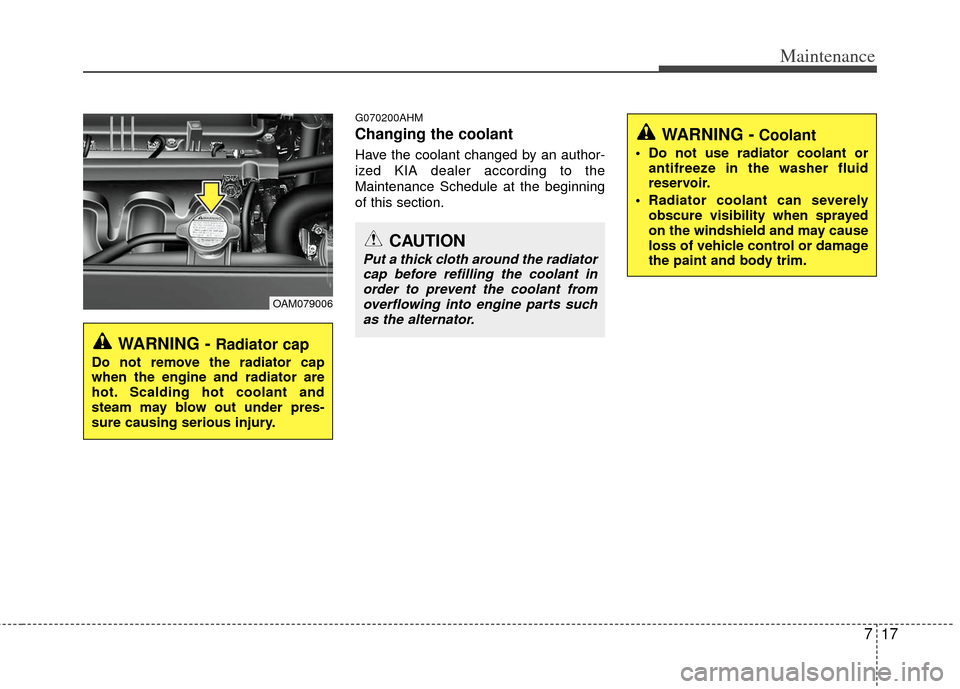
717
Maintenance
G070200AHM
Changing the coolant
Have the coolant changed by an author-
ized KIA dealer according to the
Maintenance Schedule at the beginning
of this section.
WARNING - Radiator cap
Do not remove the radiator cap
when the engine and radiator are
hot. Scalding hot coolant and
steam may blow out under pres-
sure causing serious injury.
CAUTION
Put a thick cloth around the radiatorcap before refilling the coolant inorder to prevent the coolant fromoverflowing into engine parts suchas the alternator.
WARNING -Coolant
Do not use radiator coolant or antifreeze in the washer fluid
reservoir.
Radiator coolant can severely obscure visibility when sprayed
on the windshield and may cause
loss of vehicle control or damage
the paint and body trim.
OAM079006
Page 302 of 356
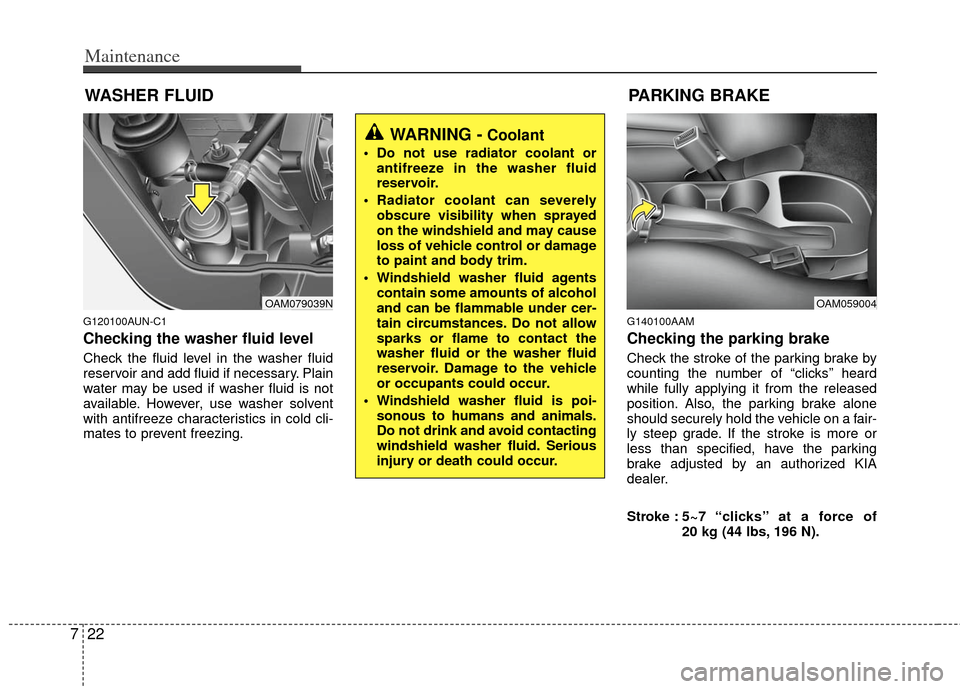
Maintenance
22
7
WASHER FLUID
G120100AUN-C1
Checking the washer fluid level
Check the fluid level in the washer fluid
reservoir and add fluid if necessary. Plain
water may be used if washer fluid is not
available. However, use washer solvent
with antifreeze characteristics in cold cli-
mates to prevent freezing.
G140100AAM
Checking the parking brake
Check the stroke of the parking brake by
counting the number of “clicks’’ heard
while fully applying it from the released
position. Also, the parking brake alone
should securely hold the vehicle on a fair-
ly steep grade. If the stroke is more or
less than specified, have the parking
brake adjusted by an authorized KIA
dealer.
Stroke : 5~7 “clicks’’ at a force of
20 kg (44 lbs, 196 N).
WARNING -Coolant
Do not use radiator coolant or
antifreeze in the washer fluid
reservoir.
Radiator coolant can severely obscure visibility when sprayed
on the windshield and may cause
loss of vehicle control or damage
to paint and body trim.
Windshield washer fluid agents contain some amounts of alcohol
and can be flammable under cer-
tain circumstances. Do not allow
sparks or flame to contact the
washer fluid or the washer fluid
reservoir. Damage to the vehicle
or occupants could occur.
Windshield washer fluid is poi- sonous to humans and animals.
Do not drink and avoid contacting
windshield washer fluid. Serious
injury or death could occur.
PARKING BRAKE
OAM079039NOAM059004
Page 320 of 356
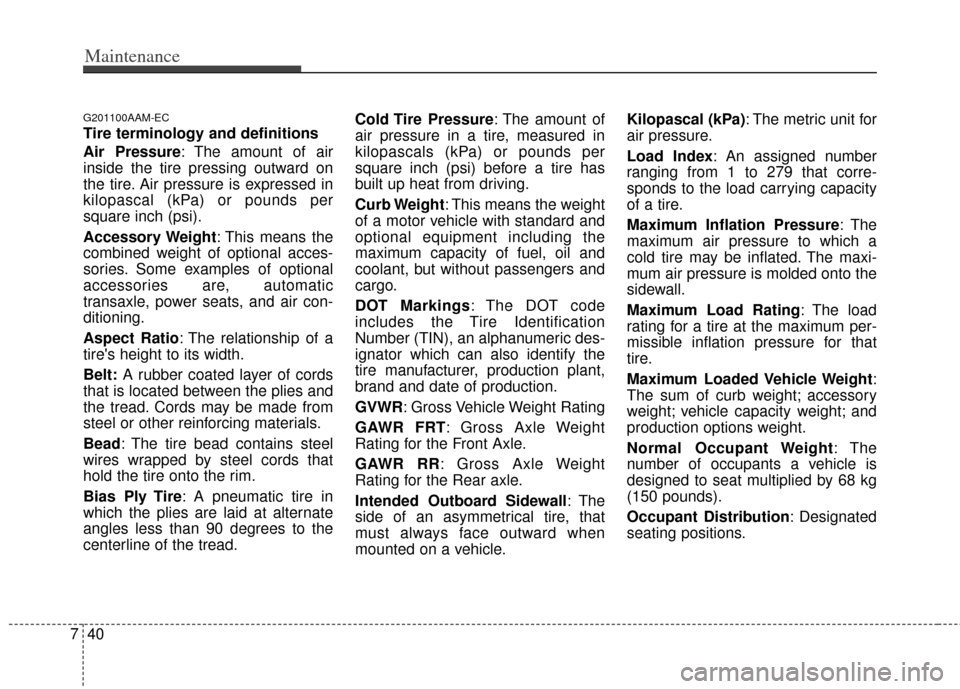
Maintenance
40
7
G201100AAM-EC
Tire terminology and definitions
Air Pressure: The amount of air
inside the tire pressing outward on
the tire. Air pressure is expressed in
kilopascal (kPa) or pounds per
square inch (psi).
Accessory Weight : This means the
combined weight of optional acces-
sories. Some examples of optional
accessories are, automatic
transaxle, power seats, and air con-
ditioning.
Aspect Ratio : The relationship of a
tire's height to its width.
Belt: A rubber coated layer of cords
that is located between the plies and
the tread. Cords may be made from
steel or other reinforcing materials.
Bead: The tire bead contains steel
wires wrapped by steel cords that
hold the tire onto the rim.
Bias Ply Tire : A pneumatic tire in
which the plies are laid at alternate
angles less than 90 degrees to the
centerline of the tread. Cold Tire Pressure: The amount of
air pressure in a tire, measured in
kilopascals (kPa) or pounds per
square inch (psi) before a tire has
built up heat from driving.
Curb Weight: This means the weight
of a motor vehicle with standard and
optional equipment including the
maximum capacity of fuel, oil and
coolant, but without passengers and
cargo.
DOT Markings: The DOT code
includes the Tire Identification
Number (TIN), an alphanumeric des-
ignator which can also identify the
tire manufacturer, production plant,
brand and date of production.
GVWR: Gross Vehicle Weight Rating
GAWR FRT: Gross Axle Weight
Rating for the Front Axle.
GAWR RR: Gross Axle Weight
Rating for the Rear axle.
Intended Outboard Sidewall
: The
side of an asymmetrical tire, that
must always face outward when
mounted on a vehicle. Kilopascal (kPa): The metric unit for
air pressure.
Load Index: An assigned number
ranging from 1 to 279 that corre-
sponds to the load carrying capacity
of a tire.
Maximum Inflation Pressure
: The
maximum air pressure to which a
cold tire may be inflated. The maxi-
mum air pressure is molded onto the
sidewall.
Maximum Load Rating : The load
rating for a tire at the maximum per-
missible inflation pressure for that
tire.
Maximum Loaded Vehicle Weight:
The sum of curb weight; accessory
weight; vehicle capacity weight; and
production options weight.
Normal Occupant Weight: The
number of occupants a vehicle is
designed to seat multiplied by 68 kg
(150 pounds).
Occupant Distribution : Designated
seating positions.
Page 339 of 356
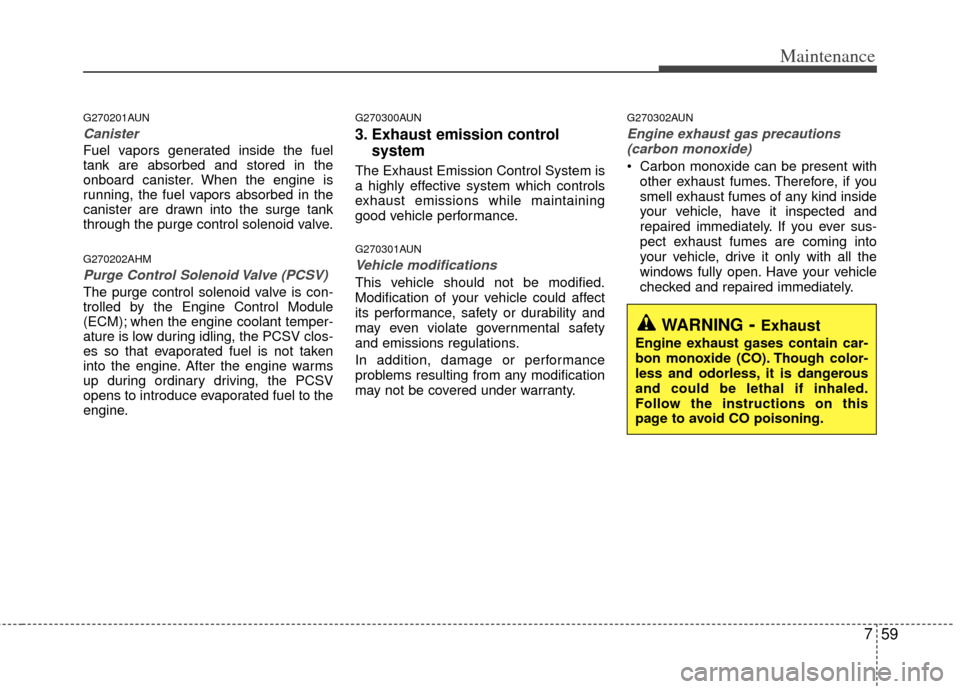
759
Maintenance
G270201AUN
Canister
Fuel vapors generated inside the fuel
tank are absorbed and stored in the
onboard canister. When the engine is
running, the fuel vapors absorbed in the
canister are drawn into the surge tank
through the purge control solenoid valve.
G270202AHM
Purge Control Solenoid Valve (PCSV)
The purge control solenoid valve is con-
trolled by the Engine Control Module
(ECM); when the engine coolant temper-
ature is low during idling, the PCSV clos-
es so that evaporated fuel is not taken
into the engine. After the engine warms
up during ordinary driving, the PCSV
opens to introduce evaporated fuel to the
engine.
G270300AUN
3. Exhaust emission control system
The Exhaust Emission Control System is
a highly effective system which controls
exhaust emissions while maintaining
good vehicle performance.
G270301AUN
Vehicle modifications
This vehicle should not be modified.
Modification of your vehicle could affect
its performance, safety or durability and
may even violate governmental safety
and emissions regulations.
In addition, damage or performance
problems resulting from any modification
may not be covered under warranty.
G270302AUN
Engine exhaust gas precautions
(carbon monoxide)
Carbon monoxide can be present with other exhaust fumes. Therefore, if you
smell exhaust fumes of any kind inside
your vehicle, have it inspected and
repaired immediately. If you ever sus-
pect exhaust fumes are coming into
your vehicle, drive it only with all the
windows fully open. Have your vehicle
checked and repaired immediately.
WARNING- Exhaust
Engine exhaust gases contain car-
bon monoxide (CO). Though color-
less and odorless, it is dangerous
and could be lethal if inhaled.
Follow the instructions on this
page to avoid CO poisoning.
Page 344 of 356
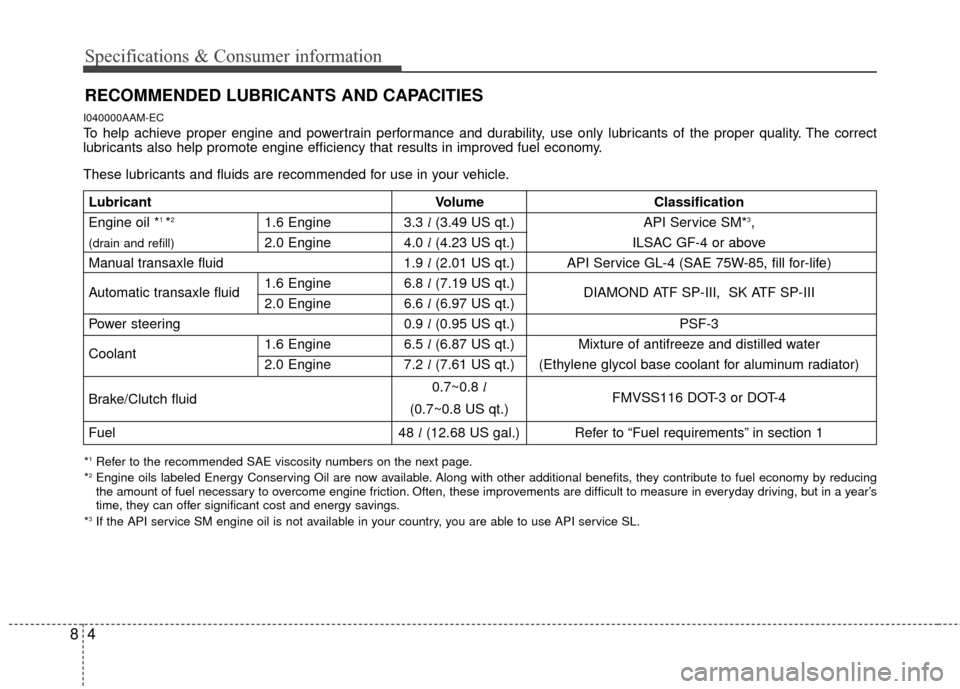
Specifications & Consumer information
48
RECOMMENDED LUBRICANTS AND CAPACITIES
I040000AAM-EC
To help achieve proper engine and powertrain performance and durability, use only lubricants of the proper quality. The correct
lubricants also help promote engine efficiency that results in improved fuel economy.
These lubricants and fluids are recommended for use in your vehicle.
*1Refer to the recommended SAE viscosity numbers on the next page.
*2Engine oils labeled Energy Conserving Oil are now available. Along with other additional benefits, they contribute to fuel econo my by reducing
the amount of fuel necessary to overcome engine friction. Often, these improvements are difficult to measure in everyday driving, but in a year’s
time, they can offer significant cost and energy savings.
*
3If the API service SM engine oil is not available in your country, you are able to use API service SL.
Lubricant Volume Classification
Engine oil *
1 *2 1.6 Engine 3.3 l (3.49 US qt.) API Service SM*3,
(drain and refill)2.0 Engine4.0 l(4.23 US qt.) ILSAC GF-4 or above
Manual transaxle fluid 1.9 l(2.01 US qt.) API Service GL-4 (SAE 75W-85, fill for-life)
Automatic transaxle fluid 1.6 Engine 6.8 l
(7.19 US qt.)
DIAMOND ATF SP-III, SK ATF SP-III
2.0 Engine 6.6 l(6.97 US qt.)
Power steering 0.9 l(0.95 US qt.) PSF-3
1.6 Engine 6.5 l (6.87 US qt.) Mixture of antifreeze and distilled water
Coolant
2.0 Engine7.2 l(7.61 US qt.) (Ethylene glycol base coolant for aluminum radiator)
Brake/Clutch fluid 0.7~0.8
l
FMVSS116 DOT-3 or DOT-4
(0.7~0.8 US qt.)
Fuel 48 l(12.68 US gal.) Refer to “Fuel requirements” in section 1
Page 350 of 356

I3
Index
Child restraint system ··················\
··················\
················3-25Auto lock mode (Passenger seat belt) ··················\
·····3-28
Lower anchor system ··················\
··················\
············3-31
Tether anchor system··················\
··················\
·············3-30
Child-protector rear door lock ··················\
··················\
···4-16
Climate control system (Automatic) ··················\
···········4-77 Air conditioning ··················\
··················\
··················\
··4-83
Automatic heating and air conditioning··················\
··4-78
Manual heating and air conditioning ··················\
······4-69
Climate control system (Manual) ··················\
···············4-68 Air conditioning ··················\
··················\
··················\
··4-73
Heating and air conditioning··················\
··················\
·4-69
Climate control air filter ··················\
··················\
············4-75
Combined instrument, see instrument cluster ···············4-37
Compact spare tire ··················\
··················\
··················\
···6-23
Compact spare tire replacement ··················\
··················\
7-35
Coolant ··················\
··················\
··················\
··················\
···7-15
Cooling fluid, see engine coolant ··················\
················7-16
Crankcase emission control system ··················\
·············7-58
Cruise control system ··················\
··················\
················5-32
Cup holder ··················\
··················\
··················\
···············4-90
Curtain air bag ··················\
··················\
··················\
·········3-51
Dashboard, see instrument cluster ··················\
···············4-37
Defogging (Windshield) ··················\
··················\
············4-84
Defogging logic (Windshield) ··················\
··················\
···4-86
Defroster (Rear window) ··················\
··················\
···········4-67 Defrosting (Windshield) ··················\
··················\
············4-84
Dimensions ··················\
··················\
··················\
················8-2
Door locks··················\
··················\
··················\
················4-13
Central door lock switch ··················\
··················\
·······4-15
Child-protector rear door lock ··················\
················4-16
Drinks holders, see cup holders··················\
··················\
·4-90
Driver's air bag··············\
··················\
··················\
·············3-45
Driving at night··················\
··················\
··················\
········5-40
Driving in flooded areas ··················\
··················\
············5-41
Driving in the rain ··················\
··················\
··················\
···5-41
Economical operation ··················\
··················\
················5-36
Electric chromic mirror (ECM) ··················\
··················\
·4-33
Electronic stability control (ESC) ··················\
···············5-27
Emergency starting ··················\
··················\
··················\
····6-4 Jump starting ··················\
··················\
··················\
·········6-4
Push starting ··················\
··················\
··················\
··········6-5
Emergency tailgate safety release··················\
················4-18
Emergency towing ··················\
··················\
··················\
···6-27
Emergency while driving··················\
··················\
·············6-2
Emission control system ··················\
··················\
············7-58 Crankcase emission control system ··················\
········7-58
Evaporative emission control (including ORVR) System ··················\
··················\
··················\
··············7-58
Exhaust emission control system ··················\
············7-59
Engine compartment ··················\
··················\
············2-4, 7-2
Engine coolant ··················\
··················\
··················\
·········7-15
D
E